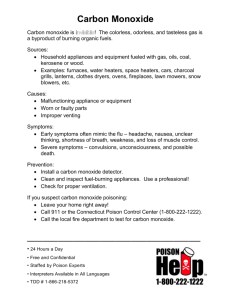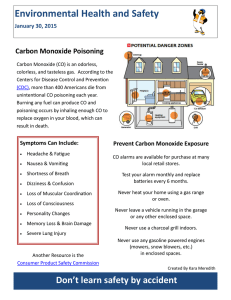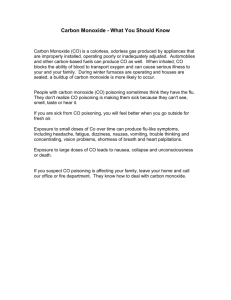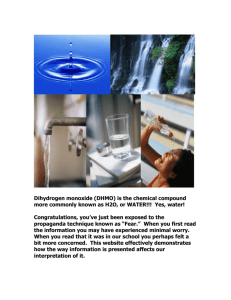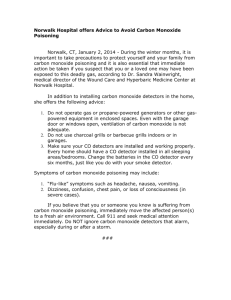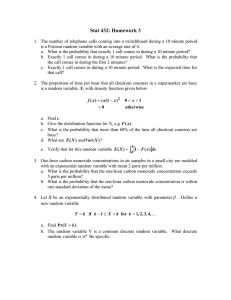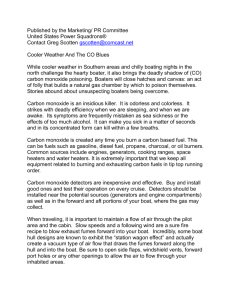Research Journal of Environmental and Earth Sciences 6(4): 189-194, 2014
advertisement
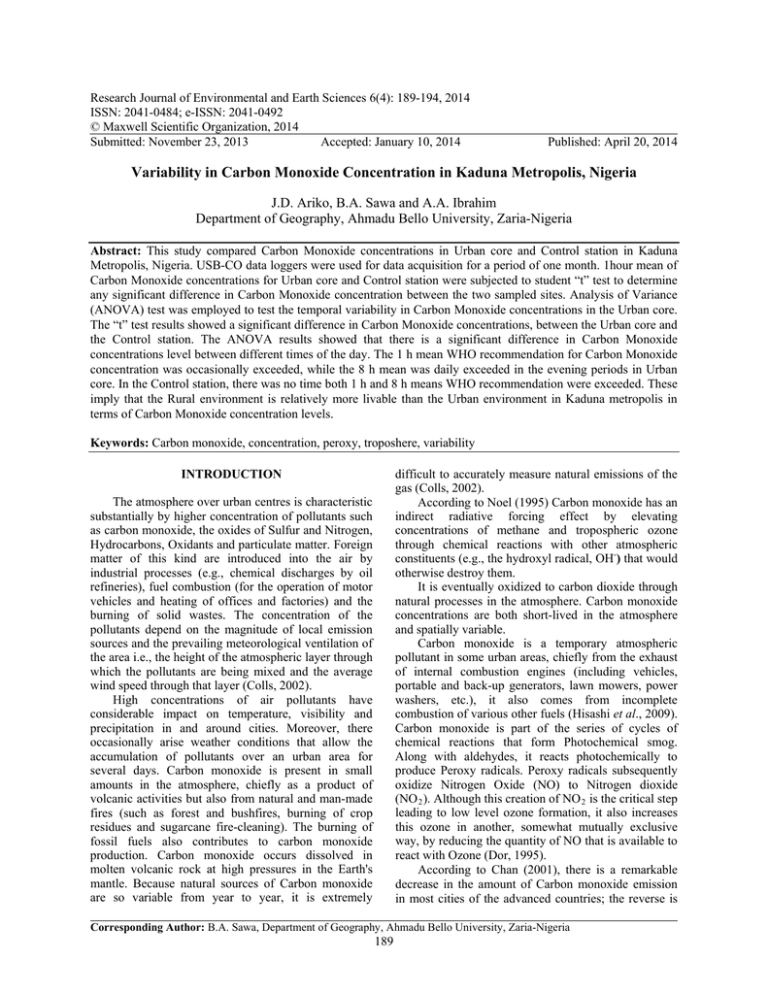
Research Journal of Environmental and Earth Sciences 6(4): 189-194, 2014 ISSN: 2041-0484; e-ISSN: 2041-0492 © Maxwell Scientific Organization, 2014 Submitted: November 23, 2013 Accepted: January 10, 2014 Published: April 20, 2014 Variability in Carbon Monoxide Concentration in Kaduna Metropolis, Nigeria J.D. Ariko, B.A. Sawa and A.A. Ibrahim Department of Geography, Ahmadu Bello University, Zaria-Nigeria Abstract: This study compared Carbon Monoxide concentrations in Urban core and Control station in Kaduna Metropolis, Nigeria. USB-CO data loggers were used for data acquisition for a period of one month. 1hour mean of Carbon Monoxide concentrations for Urban core and Control station were subjected to student “t” test to determine any significant difference in Carbon Monoxide concentration between the two sampled sites. Analysis of Variance (ANOVA) test was employed to test the temporal variability in Carbon Monoxide concentrations in the Urban core. The “t” test results showed a significant difference in Carbon Monoxide concentrations, between the Urban core and the Control station. The ANOVA results showed that there is a significant difference in Carbon Monoxide concentrations level between different times of the day. The 1 h mean WHO recommendation for Carbon Monoxide concentration was occasionally exceeded, while the 8 h mean was daily exceeded in the evening periods in Urban core. In the Control station, there was no time both 1 h and 8 h means WHO recommendation were exceeded. These imply that the Rural environment is relatively more livable than the Urban environment in Kaduna metropolis in terms of Carbon Monoxide concentration levels. Keywords: Carbon monoxide, concentration, peroxy, troposhere, variability difficult to accurately measure natural emissions of the gas (Colls, 2002). According to Noel (1995) Carbon monoxide has an indirect radiative forcing effect by elevating concentrations of methane and tropospheric ozone through chemical reactions with other atmospheric constituents (e.g., the hydroxyl radical, OH-) that would otherwise destroy them. It is eventually oxidized to carbon dioxide through natural processes in the atmosphere. Carbon monoxide concentrations are both short-lived in the atmosphere and spatially variable. Carbon monoxide is a temporary atmospheric pollutant in some urban areas, chiefly from the exhaust of internal combustion engines (including vehicles, portable and back-up generators, lawn mowers, power washers, etc.), it also comes from incomplete combustion of various other fuels (Hisashi et al., 2009). Carbon monoxide is part of the series of cycles of chemical reactions that form Photochemical smog. Along with aldehydes, it reacts photochemically to produce Peroxy radicals. Peroxy radicals subsequently oxidize Nitrogen Oxide (NO) to Nitrogen dioxide (NO 2 ). Although this creation of NO 2 is the critical step leading to low level ozone formation, it also increases this ozone in another, somewhat mutually exclusive way, by reducing the quantity of NO that is available to react with Ozone (Dor, 1995). According to Chan (2001), there is a remarkable decrease in the amount of Carbon monoxide emission in most cities of the advanced countries; the reverse is INTRODUCTION The atmosphere over urban centres is characteristic substantially by higher concentration of pollutants such as carbon monoxide, the oxides of Sulfur and Nitrogen, Hydrocarbons, Oxidants and particulate matter. Foreign matter of this kind are introduced into the air by industrial processes (e.g., chemical discharges by oil refineries), fuel combustion (for the operation of motor vehicles and heating of offices and factories) and the burning of solid wastes. The concentration of the pollutants depend on the magnitude of local emission sources and the prevailing meteorological ventilation of the area i.e., the height of the atmospheric layer through which the pollutants are being mixed and the average wind speed through that layer (Colls, 2002). High concentrations of air pollutants have considerable impact on temperature, visibility and precipitation in and around cities. Moreover, there occasionally arise weather conditions that allow the accumulation of pollutants over an urban area for several days. Carbon monoxide is present in small amounts in the atmosphere, chiefly as a product of volcanic activities but also from natural and man-made fires (such as forest and bushfires, burning of crop residues and sugarcane fire-cleaning). The burning of fossil fuels also contributes to carbon monoxide production. Carbon monoxide occurs dissolved in molten volcanic rock at high pressures in the Earth's mantle. Because natural sources of Carbon monoxide are so variable from year to year, it is extremely Corresponding Author: B.A. Sawa, Department of Geography, Ahmadu Bello University, Zaria-Nigeria 189 Res. J. Environ. Earth Sci., 6(4): 189-194, 2014 the case in most densely populated cities of the developing countries. He attributed this variation to the differences in the nature of vehicles used in these countries. According to him, most of the vehicles that ply most roads in developing countries are secondhand vehicles that emit toxic gaseous pollutants which include Carbon monoxide. Natural background levels of Carbon monoxide fall in the range of 10-200 parts per billion (ppb). Levels in urban areas are highly variable, depending upon weather conditions and traffic density. Concentrations are generally less than 10 parts per million (ppm) but can be as high as 500 pp (Duncan, 1996). The level of exposure of city residents to Carbon monoxide emission determine their health status (Dor, 1995). Most of the categories of people that face the problem of Carbon monoxide emission in most cities of the world are the preschool children (Alms, 2004). Emission of this gas varies with time and in space. There are areas that emit Carbon monoxide more than others, while the emission is higher at some period than the other (Hisashi et al., 2009). However, the rate of emission of Carbon monoxide is subject to the policies of the Authority of a particular location. The fall in trend of Carbon monoxide emission in developed countries, is accounted by the policies of the government of these countries (Sonja and Helmut, 1995). Other sources of Carbon monoxide in developing countries include: the improper or incomplete burning of natural gas or carbon-based fuels (such as propane, gasoline, kerosene, wood, coal and charcoal), un-vented Fig. 1: Kaduna Metropolis; GIS Research Laboratory, Department of Geography, ABU, Zaria (2013) 190 Res. J. Environ. Earth Sci., 6(4): 189-194, 2014 or improperly vented heaters and furnaces (which lead to increase in Carbon monoxide poisoning cases during the winter months), Auto exhausts, Tobacco smoke, faulty chimneys or fireplaces, faulty fuel burning gadgets such as space heaters and gasoline engines, gas appliances and heaters in small and enclosed spaces, faulty central heating systems and blockages that can cause improper ventilation in enclosed spaces where fuel is burned (Zhang, 1999). In Nigeria, fuel combustion in cars was the only major source of this obnoxious gas (Utang and Peterside, 2011). This has been overtaken by the numerous electric generating sets which dot the whole country-both in rural and urban settlements. Though there is no accurate figure of the number of generating sets in the country, it is believed that on the average, one in every four households in the rural areas and one in every two in the urban centres has a generator. Coupled with the large number of second hand vehicles in the country, one can imagine the amount of Carbon monoxide that finds its way to the atmosphere in most cities in Nigeria (Koku and Osuntogun, 2007). Most of the emerging cities in developing countries have the carbon monoxide concentration level that exceed WHO 8 h average recommendation at the city core throughout the daytime (WHO, 2004). This study therefore looks at the variability in Carbon Monoxide concentration in Kaduna Metropolis. This will help in measuring the livability of this tropical humid city in terms of carbon monoxide concentration. THE STUDY AREA Meanwhile, the seasonal character of rainfall in the study area has influenced the vegetation which turns evergreen during the wet season and pale brown in the dry season respectively (Oguntoyinbo et al., 1983). The soils in the study area have been classified according to Hoores classification scheme for Africa as tropical ferruginous soil. They are zonal soils developed under climatic regimes with appreciable but seasonal rainfall of 500-1200 mm and cover nearly half of Northern Nigeria (Oguntoyinbo et al., 1983). The geology of the study area is part of the basement complex geology of central Nigeria. It is composed of older high grade metamorphosed gnesis interspersed by belt of young metasediment of mainly quartzites and schist. The region is underlain by older granitic crystalline, metamorphic rocks of precambrain to low Paleozoic age (Oguntoyinbo et al., 1983). It also consists of gneisses which has suffered intense weathering and have remained stable for million of years. The prolonged weathering under tropical bioclimatic condition has produced rolling plains dotted with residuals of different origin (Motimore, 1970). The area is drained by river Kaduna and characterized by high stream frequencies and drainage density. The river drains mostly during the raining season and characterized by seasonal and ephemeral attributes. River Kaduna takes its source from the highland of Jos. It is a great resource for various water usages (Oguntoyinbo et al., 1983). Kaduna is a trade centre and a major transportation hub for the surrounding agricultural areas with its rail and road junction. The population of Kaduna is at 760, 084 as of the 2006 Nigerian census. The symbol of Kaduna is the crocodile, called kada in the native Hausa language. Available evidence shows that, the town is inhibited by over 200 different ethnic groups, with Hausa and English as the most general languages used as media of communication. Kaduna is an industrial center of Northern Nigeria, which has attracted population from most states in the north and Nigeria at large. There are two airports: Kaduna and Zaria (Kaduna State Government, 2012). Kaduna is the capital of Kaduna State in northWestern Nigeria. The city is located between Lat.10°23'10°43'N and Long 7°17'-7°37'E, near Kaduna River (Fig. 1). The area comprises Kaduna north Local Government, Kaduna south Local Government, southern part of Igabi Local Government and the northern part of Chikun Local Government. Kaduna Metropolis is about 912 km north of Gulf of Guinea, about 390 Km from Nigeria’s northern border and 180 km from Abuja, the country’s capital city. It covers roughly over 35 km2. According to Ayoade (1988), Kaduna has a tropical METHODOLOGY continental climate type characterized by wet and dry season. The tropical continental is more pronounced in This study was based on Urban-rural comparison the dry season particularly in December and January. approach (Steward and Oke, 2009). The site selections The dry season is dominated by the north-east trade wind for this study was based on Local Climatic Zones called Harmattan which prevails between November and (LCZ) categorization by Steward and Oke (2009) and February. The dry season is also rainless from October to are in accordance with World Meteorological April. The wet season is dominated by the south-east Organization standard. The sites that best represent the tropical maritime winds which start between May/June Local Climatic Zones (LCZ) category for urban core to October (Ayoade, 1988). and a control rural station were selected. The natural vegetation of the study area is that of the The Carbon monoxide data were measured and Northern Guinea Savanna with grass dominating and recorded by digital USB-CO data loggers which were scattered trees hardly higher than 15 ft with broad leaves. mounted in the urban core and rural control stations, for 191 Res. J. Environ. Earth Sci., 6(4): 189-194, 2014 a period of one month in 2013. A total of 8064 Carbon monoxide concentration values were measured and recorded, which were downloaded from the data loggers to a computer. The 8064 data were summarized into 672 mean hourly values for further analysis. Simple line graphs were used to present the temporal variability in Carbon monoxides concentration in both the urban core and the Control station. To determine if there is any significant difference in Carbon Monoxide concentration between the urban core and the control station, the student’s ‘τ’ test was employed. Analysis of Variance (ANOVA) was computed to test if there is any significant difference in Carbon monoxide concentration at different times of the day in the urban core. (35 ppm) was occasionally exceeded, but the 8 h average recommendation (10 ppm) was daily exceeded between 12:00 to 18:00. The low periods are between late evening early morning, between 21:00 to 23:59 and 0:00 to 04:00. This is a clear indication that there is temporal variability in Carbon monoxide in the urban core. Temporal variability in carbon monoxide concentration in urban core: Variations in mean Carbon monoxide concentration between the times of the day was tested by a single time factor Analysis of Variance (ANOVA) statistics at 0.05 level of significance. The result is presented in Table 1. The result in Table 1 revealed that the mean temporal differences in Carbon monoxide concentration between different times of the day are statistically significant. This is a clear indication that there is a temporal variability in Carbon monoxide concentration in the urban core. RESULTS AND DISCUSSION Carbon monoxide concentration in urban core: Figure 2 presents 5 mint mean concentration of Carbon monoxide in the urban core. From Fig. 2, it is observed that Carbon monoxide concentration in the Urban core of Kaduna exhibits a regular patter. The diurnal pattern shows two peak periods; in the morning between 9:00 to 11:00 and early evening between 15:30 to18:00. This corroborates Oke and Stewart (2009) and Hisashi et al. (2009). These periods correspond with the peak periods of commercial activities in this area. A maximum value of 88.5 ppm was recorded in the urban core. The result revealed that the WHO recommendation for 1 h average Carbon monoxide concentration in rural control station: Figure 3 shows the 5 min mean concentration of Carbon monoxide in the rural control station. It can be deduced from Fig. 3 that there is a very low concentration in Carbon monoxide in the Control station. Unlike in the urban core, there was no time both the 1 h and 8 h WHO mean averages were exceeded. The Carbon monoxide concentration shows no pattern with only few instances with concentration of between 2-5 ppm. There was only one record of 12 ppm Fig. 2: Five minutes mean carbon monoxide concentration in urban core 192 Res. J. Environ. Earth Sci., 6(4): 189-194, 2014 Fig. 3: Five minutes mean carbon monoxide concentration in control station Table 1: ANOVA results for temporal variability in CO concentration in urban core Variance SS DF. Mean square Between groups 969.075 3 323.025 Within groups 8364.713 675 12.392 Total 9333.788 678 F 26.067 Sig. level 0.001 Table 2: Student’s τ-test result for variability in carbon monoxide concentration between the urban core and the rural control station Location N Mean S.D Mean dif. t-value df Sig. level Urban core 659 5.6352 3.967 5.633 36.45 13016 0.001 Control station 659 0.0024 0.422 concentration, which may be due to the transfer from other areas due to meteorological conditions at that time. The Control station meets Grassland natural series of Oke and Stewart (2009) Local Climate Zones (LCZ) categorization. The result obtained from the area revealed that the natural environment have only traces of Carbon Monoxide and are safe. The traces of Carbon monoxide found in the rural area may be due to atmospheric instability, unlike the urban core where its concentration is as a result of anthropogenic factors. Chan (2001) observed, tall and close buildings affect wind flow which in turn has influence on the rate of gaseous pollutant dispersion and circulation. Moreover, the Control station which mimics the natural environment has little or no human activities that serve as the anthropogenic sources of Carbon monoxide emission. The absence of artificial structures and surfaces allow free circulation of air resulting in spontaneous dispersion of the little Carbon monoxide that may have resulted from natural sources. CONCLUSION Variability in carbon monoxide concentration between urban core and rural control station: The student’s τ-test was employed in comparing the Carbon monoxide concentration of the urban core and the rural control station in order to determine the significance of the difference. The summary of the student’s τ-test is shown in the Table 2. Table 2 reveals that the mean difference of the concentration is 5.633 ppm. This implies that the Urban core has 5.633 mean Carbon monoxide concentration greater than the rural station. The τ-test result indicates a significant difference in Carbon monoxide concentration between the two Local Climatic Zones (LCZ) at 0.05 level of significance. The causes of this variability may not be far from the configuration of the buildings in the Urban core. As From the findings of the study, the urban area has more Carbon monoxide concentration thatn the rural areas. The high Carbon monoxide concentration in urban areas are associated with health problems in the cities. In an attempt to proffer solutions to the problems, the following recommendations are made: • • 193 Urban planners and other relevant agency should employ policies that will encourage decongestion of the congested parts of major cities. This will allow free movement of air, dispersion of pollutants and rapid heat circulation in order to increase the livability of the Urban centers. More roads need to be constructed in major Urban centers, to decongest vehicular volume on existing Res. J. Environ. Earth Sci., 6(4): 189-194, 2014 road networks. This will go along way to reduce the concentration of air pollutants in the urban core. Koku, C. and B. Osuntogun, 2007. Environmentalimpacts of rpad transportaion in Southwestern States of Nigeria. J. Appl. Sci., 7: 16. Motimore, M.J., 1970. Zaria and its Region. Geography Department Ocassional Paper No. 4, Ahmadu Bello University, Zaria. Noel, D.N., 1995. Air Pollution Control Engineering. McGrawn-Hill, New York. Oguntoyinbo, J.S., O. Areola and M.O. Filani, 1983. Geography of Nigerian Development. 2nd Edn., Heinemann Educational Books, Jericho, Ibadan. Sonja, B. and W. Helmut, 1995. The Politics of Reducing Vehicular Emission in Britain and Germany. Pinter Fairleigh Dickinson University Press, London. Steward, I. and T. Oke, 2009. Classifying Urban Climate Sites by " Local Climate Zones: The Case of Nagano. Proceeding of the 7th International Conference on Urban Climate. Yakohama, Japan. Utang, P. and K. Peterside, 2011. Spatio-temporal variation in urban vehicular emission in Port Harcourt city, Nigeria. Ethiopian J. Environ. Stud. Manag., 4(2): 38-49. WHO, 2004. Environmentsl Health Criteria 213: Carbon Monoxide. 2nd Edn., WHO, Geneva. Zhang, J., 1999. Carbon monoxide from cookstoves in developing countries. Chemosphere, 1: 353-366. REFERENCES Alms, S., 2004. Personal exposure of preschool children to carbon monoxide: Role of ambient quality and gas stores. Atmos. Environ., 28: 3577-3580. Ayoade, J., 1988. Statistical analysis of rainfall over nigeria. J. State Geogr., 31: 1-29. Chan, A., 2001. Strategic Guideline for Street Canyon Geometry to Achieve Sustainable Street Air Quality. Elsewier Science Ltd., Hong Kong. Colls, J., 2002. Air Pollution. Spon Press, London, pp: 591. Dor, F., 1995. Exposure of city residents to carbon monoxide and monocyclic aromatic hydrocarbon during commuting trips in Paris metropolitan area. J. Air Waste Manage., 45: 103-110. Duncan, L., 1996. Environment and Nation State. Manchester University Press, Manchester, New York. Hisashi, Y., K. Sugawara, S. Sudos, I. Aoki and T. Nakasawa, 2009. Temporal and spatial variation of carbon monoxide over the wester part of the pacific ocean. J. Geopys. Res., 114(Dos8): 305-17. Kaduna State Government, 2012. Retrieved from: www.kadunastate.gov.ng August 24th. 194
